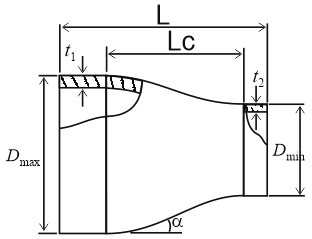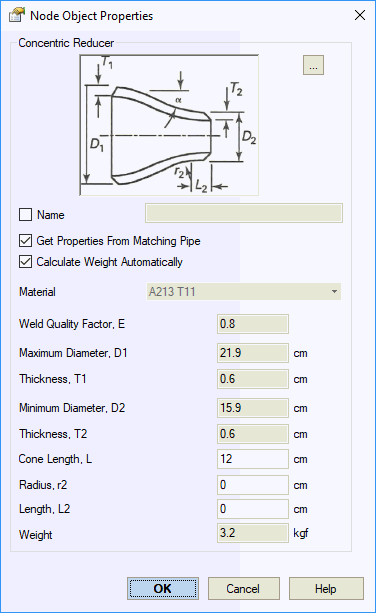



Reducers can only be placed on straight lines, and only if adjoining elements have a different diameter. The reducer node is located at the end with lower diameter.
The reducer weight is modeled as uniform load. The pipe part weight that covered by reducer is removed. Insulation and fluid weight is the average value of the weight from two connected pipes. Snow, ice, wind, and user defined uniform loads are got as average value from two connected pipes.
Features of ASME code:
START-PROF doesn't check the wall thickness for reducers. For Russian code START-PROF check the wall thickness for all reducer types.

Property |
Description |
Name |
Element name. If checked then it shown in 3D view |
Material |
Material from the materials database |
Automatic weight calculation |
If selected, reducer weight is calculated automatically as truncated cone volume taking into account wall thickness linear difference |
Weight |
Reducer weight without insulation and product. Value set in standards is used, without taking into account the overload factor. Product and insulation weight with corresponding overload factors is calculated automatically based on adjoining pipes. |
Wall thickness at Dmax, t1 |
Nominal (actual) wall thickness at maximum diameter |
Wall thickness at Dmin, t2 |
Nominal (actual) wall thickness at minimum diameter |
Mill tolerance |
Mill tolerance at the time of production. More... |
Corrosion and wear allowance |
Corrosion and wear allowance (working mill tolerance) for wall thickness. More... |
Cone length, Lc |
Length of the conical part of reducer |
Full length, L |
Full length of the reducer element |
Cone Angle, α |
The slope angle of conical part of reducer. k=2 for concentric reducer
|
Longitudinal Weld Joint Efficiency Factor, E |
Longitudinal weld joint efficiency factor, E. More... |
Manufacturing technology |
For ASME B31.1, ASME B31.3, DL/T 5366-2014 seamless pipe will always use Wl=1.0. For electric-welded pipe Wl will be specified from database. More... When using GOST 32388-2013, pipe physical properties are taken from different materials databases depending on pipe type (seamless/welded). |
Stress correlation along two axes, r |
Based on ISO 14692 section 7.10
|
Qualified stress, qs |
If this field is blank then qs is got from material database Based on ISO 14692 section 7.8
|
Internal protective layer thickness |
|
External protective layer thickness |
|
To insert an elbow, select the desired node and use the menu option: Insert > Insert Reducer > Insert Concentric Reducer
To view properties of an existing element:
Double-click the element in the 3D view
Select the
element and press the  toolbar
icon
toolbar
icon